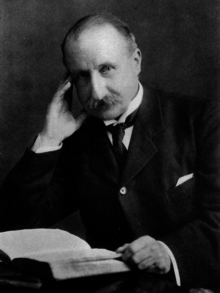James Sykes Gamble
James Sykes Gamble | |
|---|---|
 James Sykes Gamble | |
| Born | 2 July 1847 |
| Died | 16 October 1925 (aged 78) Haslemere, West Sussex |
| Known for | The book A Manual of Indian Timbers |
| Awards | Fellow of the Royal Society |
| Scientific career | |
| Fields | Botany |
James Sykes Gamble
Early life and education
Gamble was born at Portland Place, London, the second son of Harpur Gamble, M.D., R.N. and Isabella. He completed his formal education at the Royal Naval School, New Cross, before going up to Oxford, where he attended Magdalen College, studying mathematics, at which he excelled, gaining a First in the Final Schools in 1868. In the same year, he sat for the Indian Civil Service examinations, and gained an appointment in the Indian Forest Department the following year. Gamble later studied at the École nationale des eaux et forêts, Nancy (1869-1871) where he gained an interest in taxonomy.[1][2]
Career
Gamble sailed for
After retirement he continued to work on forestry, helping found the Forestry School at Oxford. His collection of nearly 50,000 specimens were gifted to Kew.[2][5]
Author of several books, his
Other works
- List of the trees, shrubs and large climbers found in the Darjeeling District, Bengal, (1st ed. 1877; 1878; 2nd ed. 1896), Bengal.
- A Manual of Indian Timbers: An Account of the Growth, Distribution and Uses of the Trees and Shrubs of India and Ceylon with Description of Their Wood-Structure. (1881; 1902).
- The Bambuseae of British India. Annals of the Royal Botanic Garden Calcutta, (1896), 133 pp.]
- Flora of the Presidency of Madras (1915–21, continued after his death by C.E.C. Fischer)
Retirement and marriage
Gamble retired to the UK in 1899, settling at Highfield,
Death
Gamble died aged 78 on 16 October 1925 at the College Hospital, Haslemere, a few days after a surgery.[1]
Honours
In 1879, botanist
In 1899, Gamble was elected a Fellow of the Royal Society, his candidature citation describing him as: 'Conservator of Forests, School Circle, NW Provinces, India, and Director of the Imperial Forest School, Dehra Dunn. Fellow of the University of Madras, and ex officio Fellow of the University of Allahabad...'[6]
Notes
NB: Gamble is listed erroneously as J. H. Gamble in some treatises.
References
- ^ a b c Obituary: James Sykes Gamble 1847-1925. Proceedings of the Royal Society of London. pp. xxxviii – xliii. Vol.99, No.699 (1 May 1926).
- ^ JSTOR 4115105.
- ^ "GAMBLE, James Sykes". Who's Who. Vol. 59. 1907. p. 655.
- doi:10.1038/116684a0.
- JSTOR 114317.
- ^ a b "Library and Archive Catalogue". Royal Society. Retrieved 31 January 2011.[permanent dead link]
- ^ "Gamblea C.B.Clarke | Plants of the World Online | Kew Science". Plants of the World Online. Retrieved 2 November 2021.
- ^ International Plant Names Index. Gamble.
External links
 Works by or about James Sykes Gamble at Wikisource
Works by or about James Sykes Gamble at Wikisource- A manual of Indian timbers (1881)
